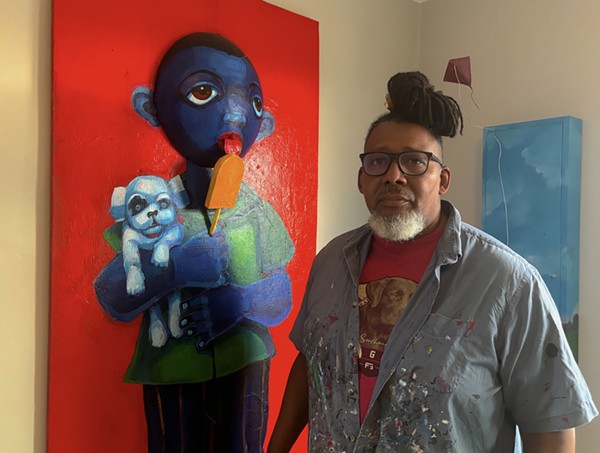Donald Calloway is busy in the kitchen, paying me no mind as I peruse his studio. He’s tending to a tall pot of peanut soup packed with strips of kale and baby corn. Then he crafts an elaborate tray of fresh rolls stuffed with oyster mushrooms atop a bed of spiralized carrots. Around them, he places cups of fruit — berries, pineapples, and grapes. Of course, he presents his food with precise attention to each detail. He’s an artist, after all.
I’m more interested in the Queen of Hearts painting hanging in the corner. The mixed media piece is part painting, part sculpture, with the queen’s blue face jutting off the canvas. She holds in her 3D arms made of who-knows-what a heart-shaped scepter, and her pursed lips give her attitude.
Across the room, nails protrude from a heart painted black. Oil portraits cover the staircase, with subjects making exaggerated and silly faces. Upstairs he’s fashioned flowers from table legs, cake molds, spatulas, and spoons. A winding wooden sculpture, folded into ribbons, seems to flow in through a window as if from another dimension.
I stop in front of a hulking piece of wood cuttings assembled in a maze — triangles, cylinders, hearts, and spools are arranged like a bumpy map of the city.
“Most of the pieces I just find,” he says, coming upstairs to tell me the food is ready. “Someone threw them out or they are pieces of other [art] pieces that I took apart.”
A few months ago he moved out of his Greektown studio, where he’s been living and working for the past 30 years, to this space owned by Irwin House Gallery. It’s located in a historic home next to the gallery on W. Grand Boulevard and is an upgrade from his former cramped and rat-infested space.
The last straw, he says of his Greektown spot, was when he came home to a pair of rats having sex in front of his door. They stopped and stared him straight in the face as if they were challenging him, “What you gone do?” Shortly after, he decided to move.

Randiah Camille Green
Calloway takes found objects and arranges them into sculptural, mixed-media pieces.
In the spring, he hopes to open a sculpture garden in the backyard of the Irwin House space and host live music along with opening the studio to the public for special events like his annual Cheap Wine & Chicken show.
Rats aside, I wonder how he decides what objects become a pair of eyes or nose on a sculpture, or why a spatula makes sense as a flower’s leaves.
“I see shapes in objects,” he tells me. Pointing to the spatula painted green underneath a blue cake pan that’s become a flower, he says, “This is really flat so I knew it would work well as a leaf. The tops of leaves are flat.”
Calloway’s art career has spanned over three decades. His work has been featured at Arts, Beats & Eats, the Palmer Park Art Fair, Charles H. Wright Museum of African American History, the Detroit Institute of Arts, Arts Extended, inside Highland Park’s Avalon Village, and many, many more.
I join Irwin House Director Misha McGlown and one of Calloway’s collectors at the dining table as Calloway serves us bowls of soups in fine china with gold trim.
He sits down, clothes covered in paint. One of his “blue babies” paintings, of a boy with blue skin licking a lollipop while he holds a puppy, has just sold. He’s going to have to take it down and put something else up in its place.
He often paints the blue babies. They’re children from the Detroit canals in Jefferson Chalmers where Calloway grew up. He remembers how they had to go out and catch fish for their dinner everyday, and would later ask neighbors to watch their buckets while they went off to play.
“Those poor children went through so much,” he says in a sad tone about why he paints them blue. It’s also a nod to the neighborhood’s waterways.
A slew of food-related paintings like a salmon steak he made from wood, plaster, and paper are hanging on the wall behind him. A meal of sculpted bacon, eggs, and toast with a thick dollop of butter sits underneath it.
More spatulas hang from sculptures in the living room and have made their way into a heart filled with paint brushes, a license plate, a 45 rpm record, and other forgotten junk.
“I never wanted to be a starving artist,” Calloway says when I ask him why food and cooking utensils appear so much in his work.
Maybe that’s why he’s such a good cook.
Subscribe to Metro Times newsletters.
Follow us: Google News | NewsBreak | Reddit | Instagram | Facebook | Twitter



